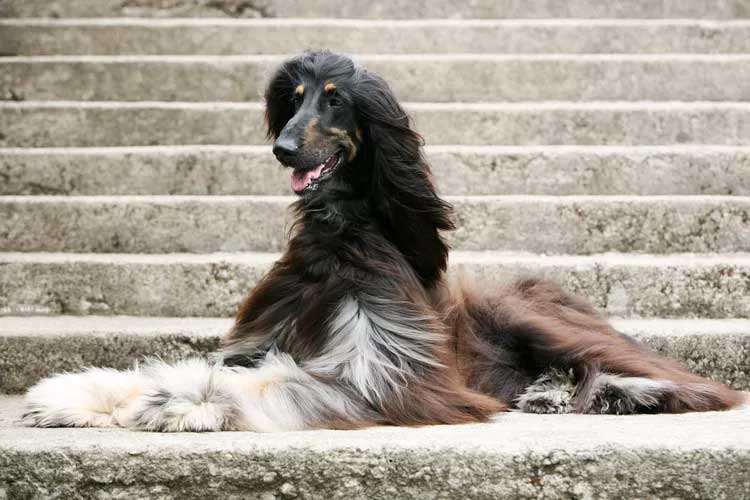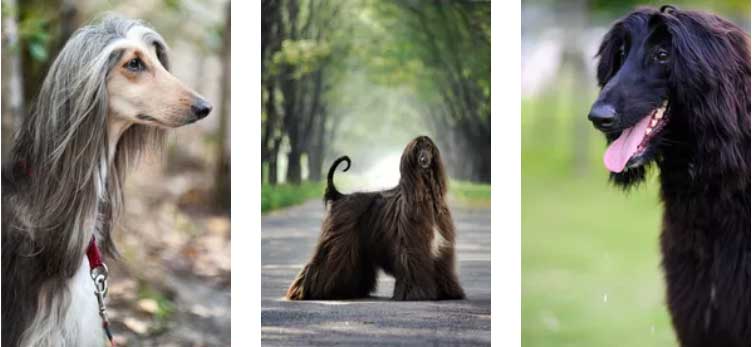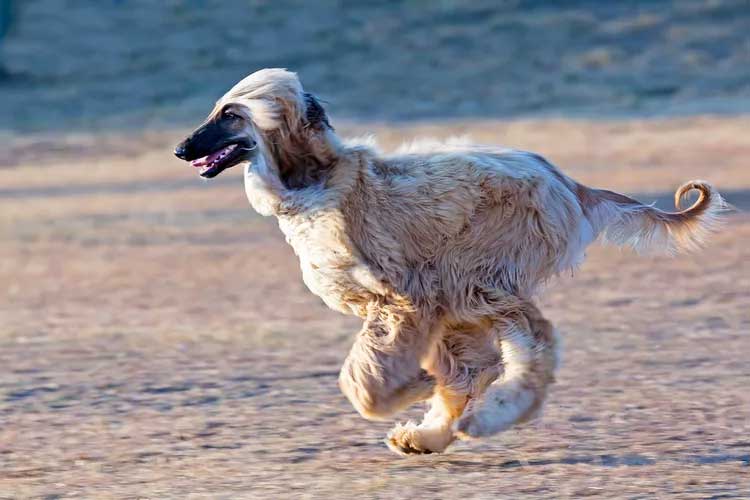Afghan hounds are aristocratic and loving dogs who can run up to 40 mph and require a serious grooming routine. Learn more about caring for an Afghan hound and if she’s the right dog for your family.

Afghan Hound Overview
| OFFICIAL NAME | Afghan Hound |
| COMMON NAME | Afghan Hound |
| PET HEIGHT | 25 to 27 inches |
| PET WEIGHT | 50 to 60 pounds |
| LIFESPAN | 12 to 15 years |
| GOOD WITH | families, seniors |
| TEMPERAMENT | aloof, gentle, playful, willful |
| INTELLIGENCE | high |
| SHEDDING AMOUNT | infrequent |
| EXERCISE NEEDS | medium |
| ENERGY LEVEL | calm |
| VOCAL LEVEL | infrequent |
| DROOL AMOUNT | low |
| BREED GROUP | hound |
| BREED SIZE | medium (26-60 lbs.) |
| COAT LENGTH | long |
| COLORS | black, blue, brown / chocolate / liver, cream, fawn, gold / yellow, gray, red, white |
| PATTERNS | bicolor, black and tan, blue and tan, brindle |
| OTHER TRAITS | apartment-friendly, cold weather tolerant, high prey drive, hypoallergenic, requires lots of grooming, tolerates being alone |
There's no getting around this one: The Afghan hound is known for her hair. That luxurious coat can come in just about any color and is usually kept long and silky. It'll require some degree of regular grooming, but the good news is that Afghan hounds shed so infrequently, they're categorized as "hypoallergenic" dogs. As medium-large pups, clocking in around 50–60 pounds, they're not lap dogs but can be a good fit for an apartment dweller if taken out regularly.
Just keep in mind that an Afghan hound, while intelligent, is also very independent—they're not easy to train, and their temperament is often compared to that of a cat's. If you're training an Afghan, remember to use positive reinforcement, find out what motivates your dog (whether that's treats, toys, or praise), and be ready with lots of time and patience. That being said, the right Afghan hound with the right owner can be a match made in heaven.
Appearance
Talk about glamorous; an Afghan hound absolutely fits that description. With her flowing silky hair, long face and solemn gaze, it's no wonder that this breed has been a symbol of status and grandeur for thousands of years. The breed standard is especially poetic: "He has a straight front, proudly carried head, eyes gazing into the distance as if in memory of ages past."Afghan hounds are tall dogs, measuring 25–27 inches at the shoulder, but they're not stocky. They generally weigh just 50–60 pounds, making them a medium-large breed. Their long face has a prominent nose, giving them a slightly Roman appearance; their ears are long; and their eyes are dark and almond-shaped. Finishing it all off is a long, thin tail that curls upward into a ring.
Their most defining characteristic is, of course, that coat. Long, silky, and flowing, it could almost belong on the head of a '70s pop diva. The hair is shorter on the face and saddle, and the dog will have a "top knot" of longer hair on her head. The Afghan hound can come in any color, but solid colors are most common. White markings are discouraged by breed purists, especially on the head.
All these traits come with a practical purpose. That coat? It kept Afghan hounds warm in the high mountains where they were bred as hunters. Their especially large paw pads were designed to protect them from rocky terrain, and their highly flexible hips enabled them to turn quickly in small areas.

Temperament
The Afghan hound temperament is a unique one: Afghan hounds are known to be reserved and aristocratic creatures, though their owners know they have a playful side. "They are described in their standard as aloof, yet gay," says Anna Stromberg, an Afghan breeder with over 40 years of experience with the breed. "That means that they have a comical side to them. And they do need an active owner that wants to spend time with their dog, but not the intense companionship that you'd get from a retriever or a working dog."Afghan hounds are not the type of dog who will jump all over you when you come home, Stromberg says. But while they're not the face-licking type, they do become attached to their owners, and can be quite affectionate. "Cat lovers tend to love the Afghan hound," she says.
That said, Afghan hounds can be a bit standoffish and wary around unfamiliar people, says Bradley Phifer, executive director of the Certification Council for Professional Dog Trainers. "[They're] just not as affectionate, not as comfortable with intimate handling, like petting and so forth," he says. Socializing your Afghan hound puppy early is vital for making her grow comfortable around new people.
One myth that Afghan hound lovers would like to dispel: This breed is unintelligent. "I think sometimes we relate smartness to trainability," Phifer says. But that's not the case, he says.
Stromberg agrees. It's not that the Afghan hound is dumb, she says, but she's independent. "The Afghan hound is not your average dog. [She] is a free-spirited, thinking, highly intelligent animal," she says.

Living Needs
As a sighthound, the Afghan hound does need space to run several times a week. Because they're powerful jumpers, any space in which you let them run off-leash should be securely fenced. And it's important to keep them on-leash when going on walks and hikes to keep them safe—because of their strong prey drive, Stromberg says, sighting a squirrel can be enough to make them bolt off after it.However, Stromberg says Afghan hounds can make wonderful apartment dogs, as long as you give them enough exercise. "You have to be an active person to own an Afghan hound," she says. "You take them for a walk, you jog, you hike, you do all of those things."
Afghan hounds don't bark much, shed infrequently, and drool very little, making them easy indoor companions. They can be taught to get along with cats and other animals (though small running animals can excite their prey drive), and can be good with children if properly socialized from the time they are puppies. And they can tolerate being left alone, though of course, as with any dog, regular physical and mental stimulation is important.
Care
The Afghan hound's grooming needs are fairly specific, according to the Afghan Hound Club of America (AHCA), but the more you do it, the less arduous it becomes. The first and most important step is regular brushing: Once your Afghan is an adult, make sure you brush her daily, or at least for several hours a week, to remove mats, tangles, and debris. The longer you delay, the worse the matting will be later, so brush her on the regular.Bathe her regularly, too, around once a week—some Afghan hound owners also like to condition the coat after shampooing. The good news is that they shed minimally compared to other breeds, which means that they're often categorized as a "hypoallergenic" breed. (And while there's no such thing as a truly hypoallergenic dog, Afghan hounds can be a good fit for some people with allergies.)
If you want to minimize hair care, you can also take your dog to the groomer for a "puppy cut," or a short haircut that's just a couple inches long. "There's no Afghan hound in this world that will have his feelings hurt if you cut their hair short!" Stromberg says.
Training an Afghan hound might be the bigger challenge: "A lot of people are getting Afghan hounds for the wrong reasons," Stromberg warns. "They want the beautiful, flowing, Farrah Fawcett-looking dream dog ... and don't realize that they're getting a conniving, small petty thief on their hands," she jokes. Stromberg describes the difference between an Afghan hound and other dogs this way: If your dog is used to getting dinner at 6 p.m. but you happen to be late one day, a border collie might have a meltdown. The Afghan hound, on the other hand, will open the fridge, help herself to some dinner, and shut the door behind her.
The first way to get a jumpstart on training is to find an Afghan hound from a reputable breeder who begins socializing the puppies from a very young age. Phifer says that time and patience are key when training an Afghan hound. "And finding the right motivation," he says. "You've got to find something that they enjoy and then be patient with the process."
It's also important to remember that they can be quite sensitive, so always stick to positive reinforcement when training. "You can't be hard on an Afghan," Phifer says. "They get their feelings hurt kind of easily. They get overwhelmed easily."
Because training an Afghan hound can be so demanding, they're not generally recommended for first-time dog owners. However, if you're a first-time dog owner and want to make the commitment, do your research and reach out to local Afghan hound groups for advice and support. The last thing an Afghan hound advocate wants to see is a dog given up because the owner just wasn't a good fit.
Health
Afghan hounds have a relatively long life span for such a large breed (about 12–15 years) and are generally healthy. But, according to the AHCA, there are some health conditions pup parents need to watch for.As with all large and deep-chested dogs, it's important for owners to recognize the symptoms of bloat, a condition in which the stomach fills with gas and cuts off circulation to other organs. When this happens, it's important to get your dog to the vet—fast—because bloat can quickly become life-threatening.
Afghan hounds can also be prone to hip dysplasia and elbow dysplasia, a condition in which the hip or elbow joints in which the joint socket is deformed and eventually causes crippling lameness. Be sure that your Afghan hound breeder has screened your puppy's parents for this and all other health conditions recommended by the Canine Health Information Center.
History
The Afghan hound originated in (you guessed it) the region now known as Afghanistan, where they were bred to hunt. DNA testing has revealed that the Afghan hound is one of the most ancient dog breeds, with a history going back thousands of years. One legend even has it that it was a pair of Afghan hounds representing dogs on Noah's Ark.Whatever their distant origins, the Afghan hound became a prized hunting companion for royals and aristocrats in the mountainous regions of central Asia, where their long coats protected them from the cold and their huge paw pads enabled them to cross the rocky terrain with ease. As sighthounds, they pursued leopards and gazelles by sight, and were bred to be sprinters.
By the late 1800s, Afghan hounds were brought to Europe by British officers returning from duty abroad. One official, Captain Banff, brought back a dog named Zardin and exhibited him at the Crystal Palace in 1907, where he became a sensation. By the 1900s, the breed had become hugely popular with the British upper crust, thanks to their elegant good looks. The Afghan hound was recognized by the American Kennel Club in 1926.
Fun Facts
Afghan hounds are sometimes called "the scented hound" for a very special reason: They are one of the few breeds of dog that has special scent glands in their cheeks that can release a pleasant, musky odor often compared to sandalwood or cinnamon. Not all Afghan hounds will have this, but some lucky ones do.Afghan hounds are also incredibly talented sprinters and can reach speeds of up to 40 miles per hour—for comparison, the fastest racehorse reached about 44 miles per hour. They're sometimes trained for lure coursing, a sport in which dogs chase after a mechanized, white plastic lure that zig zags around a field.
The Afghan hound has had some very illustrious owners over the course of history: Zeppo Marx, one of the four vaudeville stars in the Marx Brothers, was among the first to bring the Afghan hound to the U.S.. Pablo Picasso had two Afghan hounds; one named Kabul and one named Kasbac—they appeared frequently in his work. Salvador Dali and designer Givenchy both had Afghan hounds, and on a slightly more fictional (but no less iconic) level, the decades-old doll Barbie had an Afghan hound named Beauty.